Published
August 31, 2023
Right now, we have over 8.8 million jobs open in the U.S. and 5.8 million unemployed workers. Labor force participation is slowly recovering to pre-pandemic levels, but there is still a long way to go for our economy to reach its full potential.
Our America Works Data Center captures these national workforce trends. This page dives deeply into how our broken immigration system is contributing to the workforce struggles of American businesses and why our leaders need to get serious about securing our borders and modernizing our antiquated immigration system.
Recent Drops in Migration to the U.S. Have Significantly Contributed to Workforce Shortages.
The COVID-19 pandemic led to a significant drop in migration to the U.S., but many resources show the decline predated the pandemic. The Department of Homeland Security’s Yearbook of Immigration Statistics showed that the number of individuals obtaining lawful permanent resident status fell every year from 2016 to 2020. These numbers increased slightly from 2020 to 2021, when the number of new permanent residents increased from 707,362 to 740,002. By 2022, the U.S. had returned to having over 1 million people obtaining lawful permanent residence.
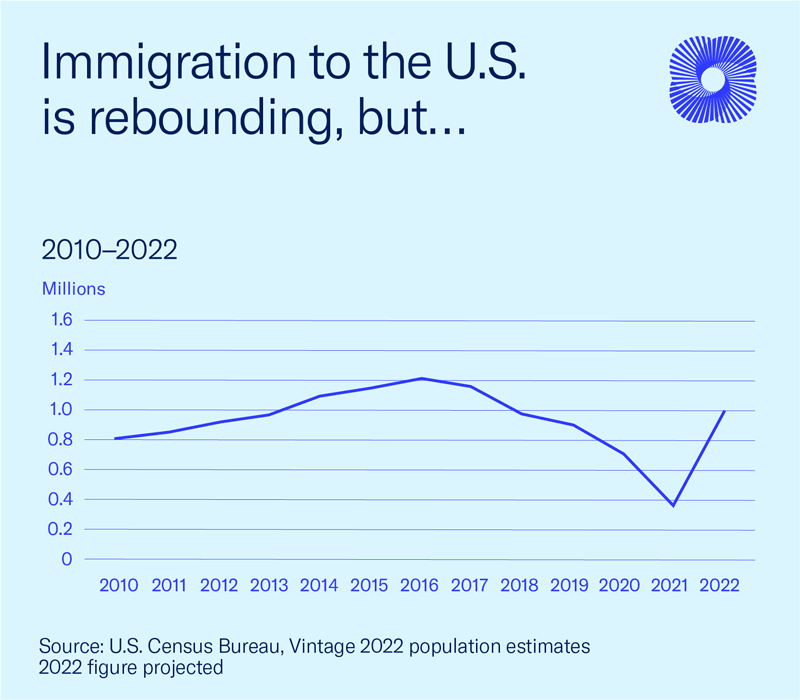
These trends are very similar to U.S. Census Bureau data on net international migration into the U.S. As with the lawful permanent resident data, the net international migration numbers fell continuously from 2016-2020, but the census data differs in that net international migration continued to fall precipitously in 2021. Net migration numbers were projected to rebound in 2022.
While different federal resources provide slightly different data points as to when and to what extent migration to the U.S. has recovered, what is clear is that the recent declines in migration to the U.S. have harmed our country The labor force impacts are still reverberating throughout our economy.
A recent study by Giovanni Peri and Reem Zaiour examined the recent declines in immigration compared to the historical migratory trends to the U.S. in the previous decade. The study concluded that the disruptions to international migration to the U.S. due to the COVID pandemic and its aftermath cost the economy approximately 1.65 million working age foreign nationals. Many tend to view these issues as problems that only impact American companies, but the American employees at these firms share in the pain from these workforce struggles. When companies cannot grow and take on new customers and clients, that means less opportunities for advancement or pay increases for the American workers at those firms.
These data, along with those cited below, show the significant challenges that individuals and employers have with navigating our nation’s legal immigration system. These challenges, which have largely gone unaddressed for decades, have contributed to the significant spike in the number of people attempting to come to our country who are not authorized to be admitted into the U.S.
Persistent Border Chaos Must Be Addressed.
While legal immigration to the U.S. may be slowly rebounding, the chaos on our southern border and the number of unauthorized entries into the U.S. has been significantly elevated in recent years. The disorder and lawlessness on the southern border is unsustainable and only Congress has the power to fix these problems.
2022 was a record year for the number of U.S. Customs and Border Protection (CBP) Enforcement Actions, which totaled 2,766,582. As of August 18, 2023, the number of enforcement actions taken by CBP for this fiscal year has hit 2,556,164. With two months left in the current fiscal year, the number of CBP enforcement actions is already at 92% of last year’s record-breaking total and it is possible that these numbers reach new heights by the end of this fiscal year.
To put this into perspective, the FY23 year-to-date total already surpassed the 1,956,519 enforcement actions taken by CBP in 2021, which was a record year until it was broken in 2022. Moreover, the only other time in the past 7 years where the number of enforcement actions was greater than 1 million was in FY19 at a total of 1,148,024. The significant increase in these enforcement actions shows that many more people in the past few years have sought to enter the U.S. without the prior legal authorization to do so. This state of affairs cannot be allowed to stand.
-
2,766,582
Number of CBP Enforcement Actions in FY22
-
2,556,164
Number of CBP Enforcement Actions through August 18, 2023
The shortcomings in CBP’s enforcement capabilities only illustrate one aspect of our nation’s border security challenges. These homeland security challenges soon turn into problems for the U.S. Department of Justice, where our nation’s immigration courts are housed. As of January 2023, the backlogs in our nation’s immigration court system have grown to 2,097,244 due to these recent surges. This backlog is larger than the population of Phoenix, Arizona, the 5th largest city in the U.S. The growth in these backlogs are such that news reports indicate that some recent arrivals aren’t scheduled to have their day in court until 2035.
The sad reality is that our nation’s border security resources are sorely lacking and are not designed to confront this situation. However, one cannot ignore that enhanced enforcement efforts alone will not solve these significant problems. Our legal immigration system is utterly inadequate to meet our nation’s economic needs. These economic and security interests are linked, which is why Congress must enact legislation that addresses both sets of challenges.
Outdated visa caps don’t meet the needs of today’s economy.
An important contributing factor to the problems businesses have in meeting their workforce needs is the antiquated, arbitrary quotas on the employment-based visa options. The decades-old, extremely low annual visa caps make it incredibly difficult for companies across a host of industries to meet their workforce needs.
The employment-based immigrant visa (green card) quotas, as well as the H-1B and H-2B quotas for temporary workers, were created in 1990 and have not been sufficiently updated to serve our national interest. In the 32 years since these caps were enacted, the size of the U.S. economy has more than quadrupled from roughly $6 trillion in 1990 to over $25 trillion in 2022, and businesses have evolved from utilizing rolodexes and fax machines to using smartphones and the internet to compete in an increasingly global marketplace.
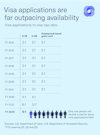
These 30-year-old visa caps are woefully insufficient to meet the needs of the American economy today. The most recent data for these programs paint a grim picture for companies struggling to meet their staffing needs, as the demand for work visas vastly outpaces the number of visas the federal government makes available.
- In FY 2021, for every three individuals seeking an employment-based immigrant visa to work in the U.S., only one of them would succeed in obtaining a visa to work in the country on a permanent basis.
- In FY 2022, for every four individuals seeking an H-2B visa to take a seasonal job in the U.S., only one of them would be able to take a job.
- In FY 2023, for every six individuals seeking an H-1B visa to work in a highly skilled field, only one of them would be able to obtain a visa.
The arbitrarily low employment-based immigrant visa quota is the primary contributing factor to the significant visa backlogs that are harming American employers and workers alike. Recent Cato Institute research shows that as of March 2023, there were approximately 1,800,524 individuals stuck in the employment-based immigrant visa processing backlogs.
These backlogs prevent individual workers from being promoted and taking on new roles in their companies and prevent companies from being able to make the best use of their talent to compete in the marketplace. Moreover, the problems associated with the low employment-based green card cap contribute to the problems associated with the H-1B program for high-skilled foreign national workers.
Companies are struggling to meet their high-skilled workforce needs due to H-1B quotas.
Technology companies, financial services firms, American manufacturers, and many other employers of high-skilled workers rely upon the H-1B program to meet their workforce needs. Unfortunately, Congress has neglected to adjust the annual H-1B quota in a manner that will allow employers to meet their workforce needs. Since FY 2014, the annual quota for these visas has been reached within a few weeks of the application period commencing.
-
780,884
Applications filed in spring 2023 for H-1B visas for Fiscal Year 2024
-
85,000
Number of new H-1B visas that will be granted in Fiscal Year 2024
An unfortunate trend is taking place where with every passing year, more and more companies find themselves falling short when it comes to acquiring the talent they need to grow and innovate. At the same time, demand for these visas has consistently increased since FY 2020. American businesses sought 201,011 new H-1B workers in FY 2020, 274,237 workers in FY 2021, 308,613 workers in FY 2022, and 483,927 workers for this current fiscal year (FY 2023).
The situation is not improving for H-1B employers—in fact, it is getting worse.
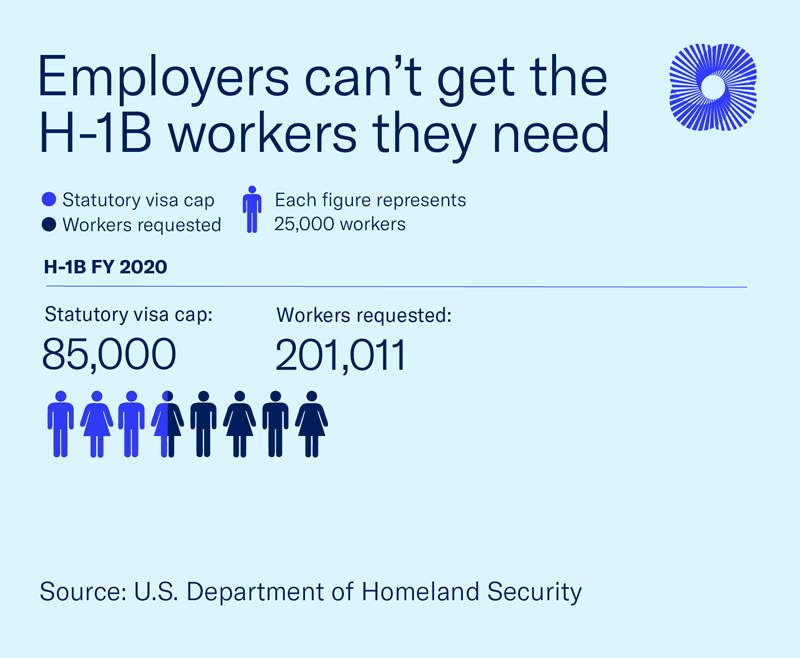
When the federal government will only allow American businesses to meet approximately 11% of their high-skilled workforce needs, it is long past time for Congress to update our immigration laws to reflect the needs of today’s economy.
There are many individuals who would love to work in the U.S. on a permanent basis, and many companies who would love to employ these people permanently. However, the lack of access to employment-based green cards pushes both companies and workers to the H-1B visa as the only option for companies to meet their labor needs in a timely fashion. Improving access to employment-based green cards would help ease some of the problems companies face when considering the H-1B as an option for meeting its workforce needs.
Businesses are Increasingly Concerned that the U.S. is Losing Ground in the Competition for International Students.
One key concern for American businesses with high-skilled workforce needs are the recent downward trends with respect to international student enrollment at U.S. colleges and universities. Many of tomorrow’s innovators are today’s foreign national college students in the U.S. These trends are similar to the aforementioned net international migration trends to the U.S. in the sense that they have begun to rebound with the subsidence of the COVID-19 pandemic, but many employers are very worried about the diminishing access to this critical source of future talent.
International student enrollment for the 2021-2022 academic year stood at 948,519. This represents a 3.8% increase over the pandemic-related low of 914,095 international students enrolled in U.S. institutions of higher education the prior year. However, international student enrollment levels haven’t been this low since the 2013/14 academic year. Moreover, even at this slightly rebounded level of enrollment, it is still a 13.4% decrease from the enrollment peak in the 2018/19 academic year.

A closer look at the data shows a divergence between undergraduate and graduate student enrollment. International enrollment for both graduate and undergraduate students had been consistently falling in the U.S. since the 2017/18 academic year, and with regard to graduate students, the decline began in the 2016/17 academic year. However, in 2021/22 academic year, graduate student enrollment rebounded back to 385,097 from its low of 329,272 in the 2020/21 academic year. Unfortunately, undergraduate enrollment for international students in the U.S. continued its descent, dropping from 359,787 in 2020/21 to 344,532 in 2021/22.

Nevertheless, neither graduate nor undergraduate of international students has reached its pre-pandemic peaks. International graduate student enrollment is still 1.6% below its peak in 2016/17, whereas enrollment for international undergraduate students is 22.2% below its peak in 2017/18.
The concerns of U.S. employers increase substantially when these trends are viewed in the context of the U.S. market share for international students. A National Foundation for American Policy report compared U.S. and Canada enrollment levels between the 2016/17 and 2019/20 academic years. That study showed a clear divergence between the U.S., where international student enrollment levels were falling, and Canada, which saw its international student enrollment level increasing significantly during that time. Specifically, the enrollment of international students in Canadian colleges and universities jumped 52%, whereas U.S. enrollment levels dropped 7.2%.
This example of competition for prospective talent is one of many that illustrate why more international students are considering their education options in other nations. The aforementioned inadequacies of the annual H-1B and employment-based green card quotas and the resulting backlogs that can force individuals to wait for decades until they obtain permanent residency are a significant reason why more students are looking elsewhere.
The rise in the State Department refusing to grant visas for international students is another significant contributing factor. A recent report by Shorelight and the President’s Alliance on Higher Education and Immigration found 54% of prospective international students from Africa were denied a student visa to study in the U.S. The report also found 36% of individuals from Asian countries and 24% of students from South American countries were denied visas to study in the U.S.
If the U.S. is to remain a top destination for talent, we cannot continue to lose out to other nation’s efforts to attract future generations of innovators.
Seasonal businesses need more H-2B visa workers.
Seasonal employers, many of whom are small businesses, use H-2B visas to meet their staffing needs. They too are struggling to meet their workforce needs with H-2B workers.
In FY 2022, seasonal businesses sought 267,986 H-2B workers. This is more than four times the annual statutory quota of 66,000. These struggles are not new. Seasonal employers sought 188,564 H-2B workers in FY 2020 and 206,011 H-2B workers in FY 2021. Even with the generous cap relief that was authorized by Congress and implemented by the Biden Administration in FY22, the number of foreign nationals granted H-2B status last year was 126,426. In other words, less than half of the seasonal workers sought by American businesses obtained a visa, leaving many companies in a bind with numerous open positions going unfilled.
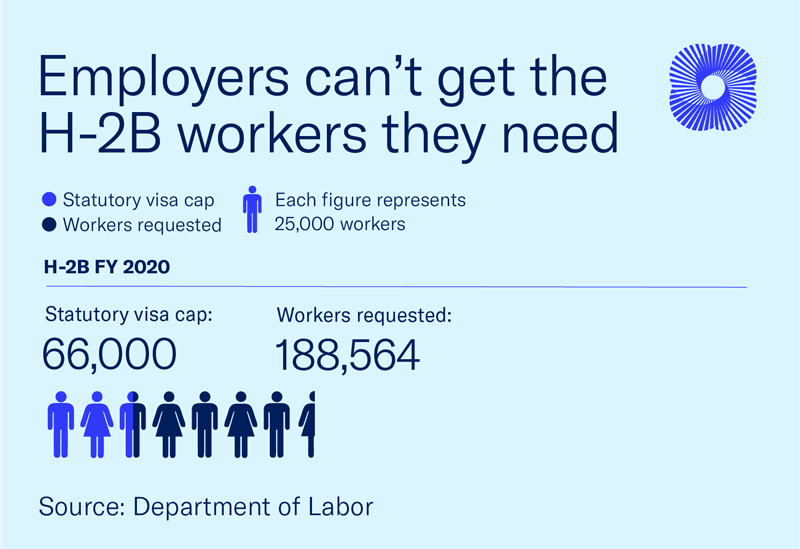
Seasonal businesses continue to confront these struggles today. The current fiscal year data on H-2B processing from the U.S. Department of Labor shows that through Q3, employers have sought 225,782 H-2B workers so far this year. Not only does this mean that companies are seeking more than 3 workers for every visa available under the statutory quota; this year’s demand for H-2B workers has already hit 84% of the H-2B worker demand for the entirety of last year. Comparing this year’s quarterly H-2B data with that from FY22, the demand for H-2B workers each quarter this year has exceeded the number of H-2B workers being sought last year. If this trend holds, this year will be worse than FY22 was for employers in terms of their struggles to find seasonal workers.
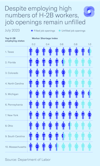
In many states where seasonal employers hire many H-2B workers for their temporary needs, there are still major labor force gaps that remain unfilled. Staffing shortages impact employers across the country seeking to fill various critical job openings, and these problems have been afflicting employers for several years. Landscapers, hotels, restaurants, carnivals, forestry companies, seafood processors, and homebuilders rely upon H-2B visa holders to meet their seasonal workforce needs. Nevertheless, these types of firms, as well as many seasonal businesses in other industries, oftentimes find themselves short-staffed during their busy seasons.
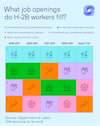
Americans agree that our nation needs secure borders and legal immigration reform.
Given the current political environment, some believe that there simply isn’t public support for any sort of legislative reforms to our broken immigration system. However, recent polling shows that there is a consensus on the need for the types of reforms that would help address the challenges described above.
A Fox News poll from February 2023 found significant bipartisan support for the following reforms:
- 74% of respondents support increasing the number of border agents,
- 73% support increasing the number of immigration judges,
- 73% support making it easier to migrate to the U.S., and
- 66% support letting immigrants with jobs in the U.S. stay in the country.

In May, U.S. Chamber of Commerce and more than 440 national, state, and local business associations joined together to launch the Legal Immigration and Border Enforcement Reform This Year (LIBERTY) Campaign. Decades of Congressional inaction has only worsened the severity of the border security and legal immigration problems afflicting our country. Nevertheless, much can be accomplished if Congress begins to work in earnest on addressing these important issues.
About the authors

Jon Baselice
Jon currently serves as the Vice President of Immigration Policy at the U.S. Chamber of Commerce. He joined the Chamber in June 2014. He works with Chamber member companies to form Chamber policy positions on various issues and he advocates for sensible immigration policies before Congress and the executive branch agencies.

Isabella Lucy
Isabella has created stunning visualizations tackling pressing issues like the worker shortage, the benefits of hiring veterans, the lifespan of small businesses, and the future of work.





